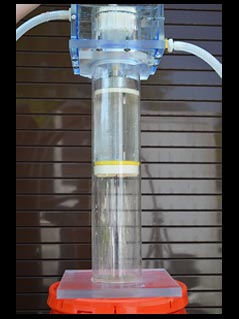U.S. Department of Transportation
Federal Highway Administration
1200 New Jersey Avenue, SE
Washington, DC 20590
202-366-4000
Federal Highway Administration Research and Technology
Coordinating, Developing, and Delivering Highway Transportation Innovations
| ARTICLE |
|
More accurate estimates of scour in erosion resistant soils could make foundation construction less difficult and less expensive.
 The picture shows an outer pipe column with an inserted cutting head, a device that will be used at bridge sites to test for scour. |
Water erodes bridge foundations. Ocean waves, for example, pound piers and abutments, stripping away sand and silt that help support them. Known as scour, this phenomenon is the most common cause of bridge failure in the United States and contributes greatly to bridge construction and maintenance costs.
Monitoring and mitigation is essential, but information to evaluate potential scour in erosion-resistant soils is scarce. Because of time and cost constraints, most scour prediction methodologies do not account for the wide range of naturally occurring soils and their resistance to erosion and scour.
But what if there was a faster and less expensive way to more accurately estimate the potential of soil erosion around bridge foundations? What if testing could be done more efficiently in the field and inform hydraulic design decisions on a project-by-project basis?
To address the need for more reliable and practical methodologies, researchers at the Federal Highway Administration’s (FHWA) J. Sterling Jones Hydraulics Research Laboratory at the Turner-Fairbank Highway Research Center (TFHRC) in McLean, Virginia are developing a scour testing field device. (This is also known as an in situ device because it will be used at actual bridge sites rather than in the laboratory.) The project is made possible through an FHWA Pooled-Fund solicitation with contributions from California, Colorado, Kansas, North Carolina, New York, Texas, Utah, Wisconsin, and the FHWA Federal Lands Highway.
“The device will have a confined column of continuously flowing water directed downward and then horizontally across the soils that are to support pier foundations,” explains Kornel Kerenyi, a senior hydraulics research engineer in FHWA’s Office of Infrastructure Research and Development. “To determine the erosion rate, the shear strength of the flow is reduced with the depth of advancing scour to reflect the natural decay of the scouring mechanism.”
Field Tests
Through physical model testing, the device will be calibrated to identify the input energy needed to produce scour depths predicted by equations for sand-bed channels. According to Bart Bergendahl, a senior hydraulic engineer in the Central Lands Federal Highway Division, “the input energy will be scaled up for a prototype device and field tests will run until equilibrium conditions are reached in the resulting scour hole, or until some maximum period of time has elapsed.”
One possibility for duration is the expected cumulative time the foundation will be exposed to design discharge over bridge life. In-situ soils will be exposed to energy necessary to develop scour depth predicted by equations. Equilibrium or maximum scour depth resulting from a field test that is less than the predicted depth for a sand-bed channel will be attributable to the erosion-resistant characteristics of in-situ soils.
“The full-scale field device is envisioned to be a closed, recirculation and filtering system that will operate in both wet and dry conditions while minimizing environmental impacts,” says Kerenyi. “The column would be suspended vertically from an overhead crane.”
Attached to the top of the column will be a weight sufficient to propel the column into the soil, incrementally upon release, as in-situ soils are scoured away by the cutting head. The progression of the cutting head and reductions in flow rate and shear will be coordinated by sensors in the head and computerized controls.
“The field device will be used for foundation analysis and design in a manner similar to present-day soil borings,” adds Bergendahl. “Testing will be conducted at proposed foundation locations across the channel and floodplain area at the site of a new bridge or replacement bridge.”
To adjust design scour depth predicted by equations for sand-bed channels and to reflect actual erodibility of in-situ soils at the bridge site, scour depth information resulting from field tests will be used in conjunction with subsurface soil boring information.
Positive Performance
Currently a second generation, lab-scale device consisting of an outer circular pipe column with a concentric cutting head centered within the column is being tested.
“To contain incoming flow and minimize soil disturbance, the outer pipe column will advance slightly ahead of the cutting head,” Kerenyi explains. “The inflow enters the cutting head-soil interface from around the perimeter of the head, flows horizontally inward across the soil, and exits vertically upward through an outlet in the center of the cutting head, carrying the eroded material away with it.”
In initial testing, the cutting head has performed well. Designed to ensure a uniform horizontal shear and symmetrical pressure distribution, it was created with 3-dimensional, computational fluid dynamics modeling performed by the super-computer at the Transportation Research Analysis Computing Center at Argonne National Laboratories in Illinois.
Outlook
Looking ahead, Kerenyi and Bergendahl plan to pressurize the lab-scale system to allow accurate control of flow and shear at the cutting head to implement the shear decay function. “This will define how the flow should be reduced with depth,” says Bergendahl. “If we’re successful, we can begin on a prototype device and auxiliary components.”
Initially, the prototype will be used for field calibration. If results are favorable, it can be used to test the erosion and scour potential of a wide range of soils types to depths of 20 meters. More accurate estimates of scour in erosion resistant cohesive, cementatious, and rock-like soils could make foundation construction less difficult and expensive.
“This research will determine if a practical field testing device can be developed to optimize expensive bridge foundation construction,” observes Kerenyi. “Preliminary results are very encouraging. If successful, the payoff of such a device will be limitless.”
For more information about the project, visit http://www.pooledfund.org/Details/Study/438, or contact Kornel Kerenyi, kornel.kerenyi@dot.gov, 202-493-3142, or Bart Bergendahl, bart.bergendahl@dot.gov, 720-963-3754.